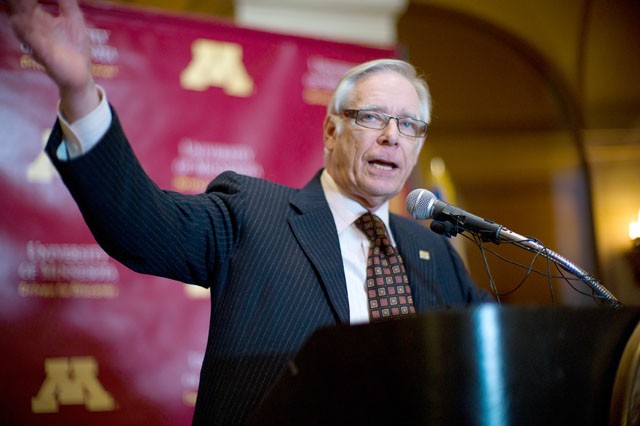More than 200 students from the University of Minnesota system rallied at the state Capitol on Tuesday for a more affordable education âÄî but few from them made the short trip from the Twin Cities campus.
The Rally to Restore Affordability, sponsored by the Minnesota Student Association, was an opportunity for students to meet lawmakers and advocate on behalf of University and student interests for the 2011 legislative session.
“What do we want? Affordability. When do we want it? Now!” chanted the crowd that filled half of the Capitol rotunda.
Identified by their green T-shirts, students from the UniversityâÄôs Morris campus made up the largest portion of the crowd with more than 110 students. Only the UniversityâÄôs Crookston campus was unrepresented.
Nick Saab, legislative affairs director for MSA, who coordinated the rally, said he was disappointed in the turnout from Twin Cities students and MSA representatives.
While students from Morris filled two coach buses, Saab estimated only 10 students who werenâÄôt MSA volunteers or Legislative Certificate Program lobbyists attended from the Twin Cities campus.
The Crookston representatives who planned to attend the rally never made it due to transportation issues en route.
University President Bob Bruininks, U.S. Rep. Keith Ellison, DFL-Minn. and state Sen. David Senjem, R-Rochester, spoke during the rally. Students from three coordinate campuses prepared testimonials to share their reasons for supporting higher education.
Gov. Mark Dayton joined the roster at the last minute after he made a request to MSA.
Dayton advocated for higher taxes on the wealthiest 5 percent of taxpayers to help balance the stateâÄôs $6.2 billion deficit, which would allow the state to continue University funding.
Applauding students for “putting the heat on” their legislators, Ellison argued that the debate over higher education funding stems from the belief that government should not be involved in peopleâÄôs lives.
“An educated person brings benefits to our whole society,” he said. “So society should help you pay for your education.”
Ellison, a University Law School graduate, said the cost of a college education can pressure students to choose more lucrative fields rather than public service fields or creative outlets.
University global studies sophomore Phillip Kelly, who met with Ellison prior to the rally, agreed that it didnâÄôt make sense for students to be burdened with debt.
Though Kelly said Ellison is already on board with students, Kelly met with him to get advice about convincing legislators.
Senjem said the Senate Higher Education Committee will fight for fair state funding for the University. The committee oversees the UniversityâÄôs 2012-13 budget request.
After the rally, Bruininks testified before the House Higher Education Policy and Finance Committee about the effects of budget cuts on the University. He also asked lawmakers to support new building projects for which the University has requested funding.
Projects like the new Physics and Nanotechnology building, relocating labs affected by Central Corridor light-rail construction and new facilities at the Itasca Biological Station make up the $109.7 million request.
Though these requests repair the UniversityâÄôs infrastructure, Bruininks stressed the importance of minimizing cuts to make sure the state is contributing 18 percent of the UniversityâÄôs budget.
“If you donâÄôt protect it, you are going to lose it,” Bruininks said of the University as an economic driver for the state.
For example, Bruininks contended that if the school faced a proposed 15 percent budget cut, it would mean eliminating 1,700 jobs.
Several Morris students said they attended the rally because they were worried about how cuts to their school would affect the community.
Leading the way in sustainable education, the Morris campus boasts wind turbines and a biomass plant, and students said they are afraid they would be shut down because of state budget cuts.








